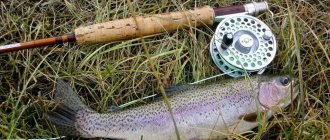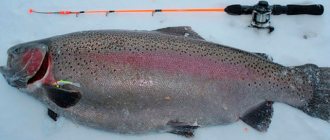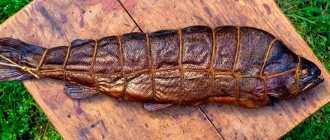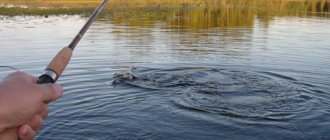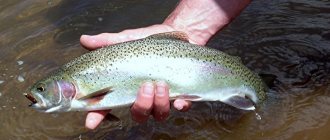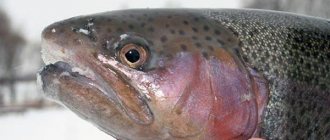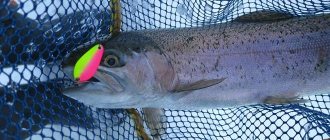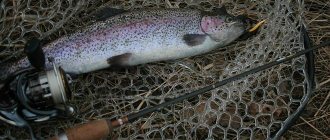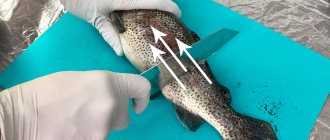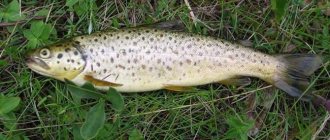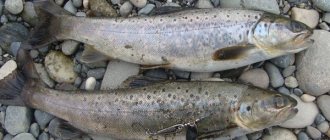What is pasta?
Trout paste is a special protein mixture with a pungent odor. The aroma can be cheese, garlic, caviar or fish. It is these types of odors that attract predators.
To make the paste, various types of fish and cheeses are used, as well as protein additives, dyes and glitter. Paste with added glitter lures trout better.
The consistency of the material is similar to plasticine. It fits easily on the hook and takes on different shapes. Different types of such bait are affordable, even if foreign products are purchased. If necessary, you can create it yourself. However, if you make trout paste with your own hands, the composition must be carefully selected to suit the preferences of the trout. Requires corn, various types of fragrant cheese, small fish, daphnia. It’s cheaper and easier to buy a ready-made mixture.
What kind of paste is there for trout fishing and what are its advantages?
Content
At the stage of preparation for fishing, the pressing question arises of what to catch trout with, and there are a lot of possible answers: live bait, artificial bait, various natural baits or paste. The last bait is a protein mixture with a high concentration of flavors. Before using paste for trout fishing, it is important to choose the appropriate scent that the fish will like. The most popular smells: red caviar, garlic, fish, cheese.
Cheese paste for fishing is one of the most promising baits, which is good for catching individuals of various sizes. The smell of caviar is loved by small species; the bite is active, but trout that have not reached sexual maturity end up on the hook. This happens because trout at a young age tend to destroy nests with eggs of their own species. Still, we do not recommend expecting that cheese paste for trout fishing will be the only popular flavor; it is better to have at least several pastes in your assortment.
Pastes differ in color; manufacturers mainly produce yellow, pink and orange versions. Some companies add glitter to the composition, which shimmers in the sun and attracts trout.
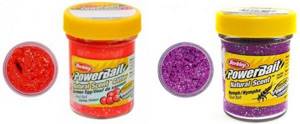
One of the most promising baits is cheese paste.
There are two types of pastes:
- sinking bait. It is used in combination with bottom gear, especially with a feeder configured for catching fish in the bottom layer of water;
- floating bait. The use of a floating nozzle is advisable when there is prey in the water column.
Both types of masses are used frequently and can lead to trout bites at any time of the year. More persistent fishermen have learned to make their own pasta; today there are many recipes online for making it yourself. For a good catch, it is better to use ready-made mixtures, because they are inexpensive and time-tested, and homemade baits are not always able to provide a good result
It’s not difficult to save on purchases; we can simply buy one type of pasta instead of two.
Read more
Wobbler "Ponton 21"
If you couldn’t guess the type of bait, it’s easy to change it to suit the conditions in the reservoir:
- To turn a sinking bait into a floating one, add foam balls to the mixture. The positive buoyancy of the foam will ensure that the bait rises to the middle or surface horizon;
- To weigh down the floating bait, we add a lead ball or bead to the composition. A correctly selected sinker will ensure that the composition sinks to the bottom.
As for the advantages of the nozzle, we highlight the following positive qualities:
- applicable in any season;
- years of experience using paste ensures that recipes are perfected and will attract fish;
- a pungent and strong odor that travels long distances;
- variety of tastes and colors;
- stays tightly on the hook.

It is better to use ready-made mixtures for a good catch.
Types and benefits of trout paste
The paste comes in several colors. The shades are chosen in such a way that they most attract fish. The most common baits are red, orange or yellow. You can also find pink and green trout paste. Some are available in two or three colors at once.
But a more significant division is by weight:
- Sinking paste . It has a slightly larger mass, so it sinks to the bottom. Suitable for catching fish that hide in holes, under snags and boulders. Often these are older, more cautious individuals. It is also necessary to take into account seasonal characteristics: at one time the trout prefers to stay closer to the surface, at another time it lies at the bottom.
- Floating paste . Floating bait is convenient to use if there are many obstacles in the reservoir. Typically, trout respond better to bait that floats on the surface because it more closely resembles a fish or an insect that has fallen into the water.
Article on the topic: Bait for trout: pellets and/or do it yourself
The best paste, according to experts, is American-made cheese paste. It has the most characteristic smell and quickly attracts fish at any time of the year. Color is also important: yellow is easily visible to trout both at depth and when using a floating bait.
Fishing for trout with paste

Fishing for trout with paste allows you to abandon expensive spinning rods and artificial baits, giving preference to cheaper and more accessible gear. Fishing for trout with paste involves the use of the following equipment:
Equipment for trout fishing with paste
Float rod
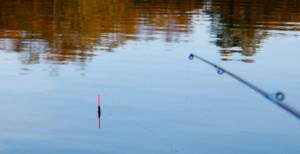
In this case, there are no special requirements for the fishing rod, but it must have the following properties: blank length within 3-4 meters, fishing line with a diameter of 0.2 mm and a length of 50 to 100 meters, to the end of which a leash with a thickness of 0.15 is attached -0.18 mm and length from 30 to 60 centimeters. Hooks will go from No. 10 to No. 14, depending on the size of the intended trophy. Any float can be used, depending on the fishing conditions. When fishing with a float rod, it is advisable to choose a floating paste.
Bottom fishing rod
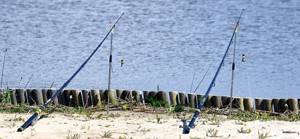
It is especially popular among fishermen because it allows you to fish at a considerable distance from the shore and at any depth. Nowadays, bottom fishing rods are equipped with a feeder rod or picker, since they are intended for this type of fishing. As a last resort, you can use a spinning rod: the result will be the same, but the tackle will cost much less. The length of the rod can be in the range of 2.5-3.3 meters, which is equipped with a spinning reel (possibly inertial if it is bottom tackle), on which a fishing line, 0.15-0.25 mm thick, is wound with a leash at the end, thick 0.2 mm. Hooks are selected depending on the size of the expected catch. These can be hooks from No. 8 to No. 12. This fishing method involves the use of sinking paste.
Trout on the feeder. Pond trout. Feeder.
Bombard
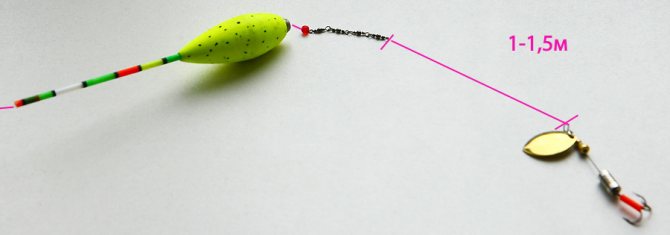
This is a very interesting equipment, the basis of which is a float with a weight, which allows you to cast the bait much further than with a regular, classic float. The presence of such gear presupposes its own specific fishing: after a long cast, a slow retrieve with pauses is carried out. Moreover, the wiring can be either uniform or uneven, with small plays along the bait. Playing with bait like this increases the chances of successful bites. This trout fishing technique involves the use of floating paste.
As mentioned above, there are two types of paste for trout fishing, depending on which option for catching this fish is intended to be used. For example:
- A sinking paste that can quickly sink to the bottom and attract trout there. In addition, sinking paste is suitable for fast retrieves and for fishing with bottom gear (feeder).
- Floating paste can remain in the water column for a long time, after which it can reach the bottom. It is preferable to use it for catching fish that are located on the middle horizon or closer to the surface.
Fishing for trout on a paid reservoir with spoons and pasta
Regardless of whether it is a sinking or floating paste, its composition includes the same basic components, which have an important impact on its main characteristics. Here they are:
- Highly concentrated protein blend.
- Natural or artificial flavors with the smell of garlic, cheese, fish products or caviar.
Gear selection
The fishing rod is not essential when using paste. All types are suitable: bottom tackle, float or bombard. In each case, you need to use baits of different weights:
- If donka is used, then the paste should be sinking, although occasionally floating is allowed. The rod should be approximately 3 meters long. Hooks - number 10 and 12, nylon fishing line about 150 meters long. The leash is selected to be about 1 meter long, the reel should be inertia-free.
- The float rod does not require a sinker and is used together with floating paste. Optimal characteristics of the gear: a leash of 0.6 meters, a fishing line 100 meters long, a hook number 10. The rod itself needs to be selected about 4 meters long.
- When fishing with a bombard, you must select variations with maximum transparency. A dark or brightly colored float will scare away wary trout. The paste should be sinking.
Although trout pastes of different weights are inexpensive, it is not necessary to buy several types of bait. It is enough to select one and then change its mass using additional elements. If you want to make a sinking paste from a floating one, add a ball of lead. If it is necessary to raise the bait to the surface, balls of foam or other lightweight material are hidden in the mass.
Putting pasta on a hook
The paste easily takes any shape without additional heating. In order to create a suitable bait, you need to take a small piece of material (about the size of a fingertip) and then roll it into a ball. The ball should be the size of a large pea. Next, the bait is placed on the hook. It is enough to simply immerse it entirely in the material. It is important to ensure that only the fishing line sticks out of the paste, and that the metal parts of the hook are not noticeable.
Article on the topic: Bait for trout: pellets and/or do it yourself
You can throw round or oblong baits into the water, or you can give them a more unusual shape. Fishing stores sell devices for changing the shape of the paste: light frames made of transparent plastic, as well as presses. Presses allow you to create any look - a small fish or a larva.
How to properly use paste for trout fishing?
Some fishermen are against the use of paste, since their experience of using bait was ineffective. Sometimes the reason is not so much the attachment as the incorrect use. In Russia, not everyone is familiar with pasta, despite the prevalence of the bait in Europe and the USA.
Read more
Lures for catching carp
Things to remember:
- store pasta correctly. If you ignore storage rules, the composition will lose its attractiveness and begin to repel fish. The main mistake of many fishermen is that they save the paste in the freezer, although the composition cannot be frozen. Low temperatures (approaching 0°C and below) lead to loss of paste abilities;
- saving is inappropriate here. During hunting and increased activity of trout, the fish is very voracious and can eat a lot of food up to 70% of its own weight. Before fishing, it is better to stock up on bait in large quantities, then the probability of catching a trophy will be significantly higher;
- Before casting, you should prepare the bait. If you skip the preparatory period, the bait will fly off the hook during the casting process. First, we recommend that you give the bait some density by squeezing it with your fingers.
How to put pasta on a hook?
The paste mixture is convenient and easy to use. Setting the bait is easy in a couple of steps:
- Separate part of the paste and roll it in your hands until it forms a large ball.
- We put the resulting ball on the hook. An important point is that it is advisable to hide not only the point, but also the entire hook, otherwise such a cautious fish will notice the catch.
- When baited, lightly squeeze the bait, creating an oval shape from it.

The assortment of stores has a special device for making bait. With the device it is much faster and easier to make bait, and the bait is more accurate.
Important! There should be a space of up to 10 cm between the paste and the sinker.
How to catch
When fishing, you need to slowly move the bait through the water, stopping periodically. The break should last from 5 to 10 seconds. If the exact location of the fish is unknown, you need to cast the fishing rod in several places, at least 5 times in each. Even if the trout is located where the bait hits, it may not react immediately. This is why it is important to check one point several times.
While fishing, you should not make sudden movements. Trout are easily spooked by making noise or making their presence known by wearing bright clothing. You need camouflage that will blend in with your surroundings.
Features of winter fishing
It's best to go fishing in late winter when the water temperature rises. In the northern regions, trout are almost inactive in winter, as they feed little. But you still need to catch her. To do this, you must follow several rules:
- Use only new holes. Where other people have already fished, the trout are more cautious.
- Use brighter baits, preferably with sparkles.
- It is also recommended to use odorous masses or masses with pheromones.
Article on the topic: Bait for trout: pellets and/or do it yourself
Trout fishing in spring
As soon as the ice has melted, you can start fishing using float rigs on both fishing rods and plugs.
Important! Fish after winter are slow and do not like moving baits, preferring to take hooks where sinking bait is mounted.
The water at this time of year is still cool and the fish are dispersed throughout the entire reservoir, attaching only to bottom anomalies. The predator is caught on a float with paste baits throughout the daylight hours. Cloudy days with light winds that raise low waves on the reservoir are preferable for fishing. Because of the murky spring waters, brightly colored baits bring out the fish more often to bite. Closer to summer, trout move to tree-shaded banks and fresh springs with cooler water. The spring bite is considered the second most important and intense in the annual fishing season for this fish.
The secret of catchy pasta
By following simple rules, even a novice angler can achieve a big catch. Here are the main secrets that should be used when fishing:
- The pasta should not be frozen. It cannot be stored in the refrigerator at home. If a fisherman travels for a long time in open areas in winter, the jar of paste should be kept in a warm car interior, deep in a bag or under a jacket.
- The paste tends to crumble. This can be easily prevented: to prevent it from coming off the hook, you need to lightly compress it with two fingers. Ready-made presses work well.
When fishing, you should not skimp on bait. The cost of the paste is incomparable to the price of trout, which can be caught with the contents of one jar. Remember that fish respond better to large baits.
